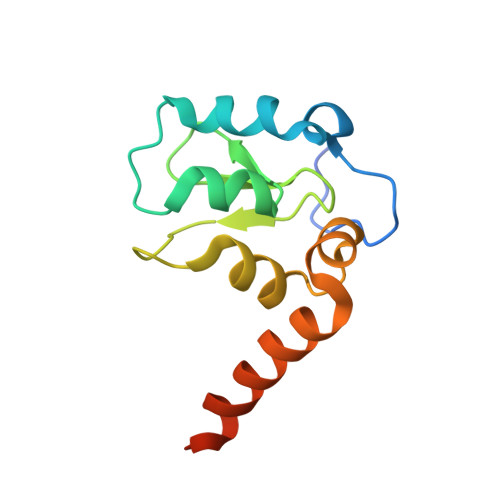Structural insight into inhibitor of apoptosis proteins recognition by a potent divalent smac-mimetic.
Cossu, F., Milani, M., Vachette, P., Malvezzi, F., Grassi, S., Lecis, D., Delia, D., Drago, C., Seneci, P., Bolognesi, M., Mastrangelo, E.(2012) PLoS One 7: e49527-e49527
- PubMed: 23166698
- DOI: https://doi.org/10.1371/journal.pone.0049527
- Primary Citation of Related Structures:
4EB9, 4EC4 - PubMed Abstract:
Genetic alterations enhancing cell survival and suppressing apoptosis are hallmarks of cancer that significantly reduce the efficacy of chemotherapy or radiotherapy. The Inhibitor of Apoptosis Protein (IAP) family hosts conserved proteins in the apoptotic pathway whose over-expression, frequently found in tumours, potentiates survival and resistance to anticancer agents. In humans, IAPs comprise eight members hosting one or more structural Baculoviral IAP Repeat (BIR) domains. Cellular IAPs (cIAP1 and 2) indirectly inhibit caspase-8 activation, and regulate both the canonical and the non-canonical NF-κB signaling pathways. In contrast to cIAPs, XIAP (X chromosome-linked Inhibitor of Apoptosis Protein) inhibits directly the effector caspases-3 and -7 through its BIR2 domain, and initiator caspase-9 through its BIR3 domain; molecular docking studies suggested that Smac/DIABLO antagonizes XIAP by simultaneously targeting both BIR2 and BIR3 domains. Here we report analytical gel filtration, crystallographic and SAXS experiments on cIAP1-BIR3, XIAP-BIR3 and XIAP-BIR2BIR3 domains, alone and in the presence of compound 9a, a divalent homodimeric Smac mimetic. 9a is shown to bind two BIR domains inter- (in the case of two BIR3) and intra-molecularly (in the case of XIAP-BIR2BIR3), with higher affinity for cIAP1-BIR3, relative to XIAP-BIR3. Despite the different crystal lattice packing, 9a maintains a right handed helical conformation in both cIAP1-BIR3 and XIAP-BIR3 crystals, that is likely conserved in solution as shown by SAXS data. Our structural results demonstrate that the 9a linker length, its conformational degrees of freedom and its hydrophobicity, warrant an overall compact structure with optimal solvent exposure of its two active moieties for IAPs binding. Our results show that 9a is a good candidate for pre-clinical and clinical studies, worth of further investigations in the field of cancer therapy.
Organizational Affiliation:
Department of Biosciences, University of Milano, Milano, Italy.


















